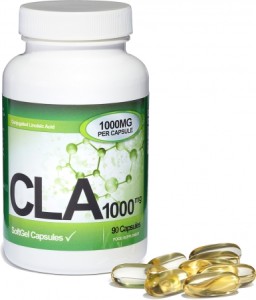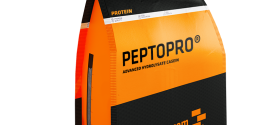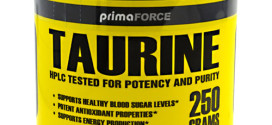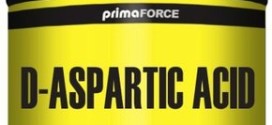Supplement Ingredient Guide: Conjugated linoleic acid

What is it?
Conjugated linoleic acid (also known as CLA) is a naturally occurring fatty acid present mainly within food products from grass-fed ruminants, eggs and certain mushrooms.
Indications
It is primarily indicated for those looking to lose weight however it has also been shown to aid development of lean mass.
How much should I take?
It is recommend that you take between 2-3.5g of CLA per day with 3.4g being the best preforming dose. You are advised to take the dose split over 2 times a day.
Research
Evidence surrounding CLA is conflicting, however recent 2007 meta-analysis has shown that supplementation of CLA alongside regular exercise can reduce body fat and aid the development of lean muscle. The changes in body mass might not be significant, however the body composition does change significantly.
The mechanism of action of CLA is not fully understood since it acts like a fat yet isn’t used to provide energy as you would assume. Research suggests that CLA is able to inhibit the enzymes responsible for the production of inflammatory proteins, but also it was found that CLA blocks the production of an enzyme that helps your body store body fat. CLA may also act as an antioxidant –fighting free radical damage in cells. However, all the research seems to come to the same conclusion, which is CLA is able to burn fat, stimulate muscle gain and increase metabolism.
A lot of research on overweight people comes to the conclusion that their rate of metabolism increases dramatically, by extrapolating that research onto people whom are working out regularly the results were the same, some published papers even go further and claim that the results are more impressive.
A paper published in 2001 out of Sweden claims that CLA was able to “Decrease abdominal fat, without concomitant effects on overall obesity or other cardiovascular risk factors”, suggesting it was a targeted fat loss which could be explained by the increased cellular sensitivity to insulin preventing the unwanted abdominal fat storage.
Side effects
One study found that CLA increases oxidative stress, while another found that taking CLA regularly made you 1/3 more likely to develop gallstones. So one should be careful when taking it. Another side effect which people have noticed is a flaring up of the acne, but that’s usually down to the ingredients used to form the tablets rather than being down to the active ingredient.
Refernces
1. Terpstra AHM. Effects of conjugated linoleic acid on body composition and plasma lipids in humans: an overview of the literature. Am J Clin Nutr 2004;79:352–61
2. U Risérus, L Berglund and B Vessby. Conjugated linoleic acid (CLA) reduced abdominal adipose tissue in obese middle-aged men with signs of the metabolic syndrome: a randomised controlled trial International Journal of Obesity (2001)25, 1129-1135
3. Gaullier JM, Halse J, Hoye K, Kristiansen K, Fagertun H, Vik H, Gudmundsen O. Conjugated linoleic acid supplementation for 1 y reduces body fat mass in healthy overweight humans. Amer Jour of Clin Nutr 2004; 79 (6): 1118-1125
4. Risérus U, Vessby B, Ärnlöv J, Basu S. Effects of cis-9,trans-11 conjugated linoleic acid supplementation on insulin sensitivity, lipid peroxidation, and proinflammatory markers in obese men. Am J Clin Nutr. 2004; 80 (2): 279-83.
5. Blankson H, Stakkestad JA, Fagertun H, Thom E, Wadstein J, Gudmundsen O. Conjugated Linoleic Acid Reduces Body Fat Mass in Overweight and Obese Humans. Journal of Nutr 2000; 130: 2943-48 PMID 11110851
6. Kim YJ, Lee KW, Lee HJ. Total Antioxidant Capacity of Arginine-Conjugated Linoleic Acid (CLA) Complex. J. Agric. Food Chem 2004; 52 (3): 439-44
7. Blankson, H., Stakkestad, J. A., Fagertun, H., Thom, E., Wadstein, J. and Gudmundsen, O. (2000). Conjugated linoleic acid reduces body fat mass in overweight and obese humans. Journal of Nutrition. 130, 2943-2948.
8. Gaullier, J. M., Halse, J., Hoye, K., Kristiansen, K., Fagertun, H., Vik, H. and Gudmunsen, O. (2005) Supplementation with conjugated linoleic acid for 24 months is well tolerated by and reduces body fat mass in healthy, overweight humans. J Nutr. 135 (4), 778-784.
9. Kamphuis, M. M., Lejune, M. P., Saris, W. H. and Westerterp-Plantenga, M. S. (2003) Effect of conjugated linoleic acid supplementation after weight loss on appetite and food intake in overweight subjects. Eur J Clin Nutr. 57 (10), 1268-1274.
10. Lowery, L. M., Apicelli, P. A. and Lemon, P. W. R. (1998) Conjugated linoleic acid enhances muscle muscle size and strength gains in novice bodybuilders. Medicine and Science in Sports and Exercise. 30, S182.
11. Whingham LD, Watras CA, Scholler DA (2007). “Efficacy of conjugated linoleic acid for reducing fat mass: a meta-analysis in humans. Am”. J Clin Nutr 85 (5): 1203–1200.
 Supplement Judge Unbiased Supplement Reviews – Do they really work??
Supplement Judge Unbiased Supplement Reviews – Do they really work??





[…] Starch and creatine. For anyone looking to step it up a level higher I’d recommend fish oil, CLA, Glutamine and […]